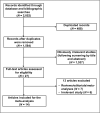Association between XRCC3 p.Thr241Met polymorphism and risk of glioma: A systematic review and meta-analysis
- PMID: 36264998
- PMCID: PMC9584405
- DOI: 10.1371/journal.pone.0276313
Association between XRCC3 p.Thr241Met polymorphism and risk of glioma: A systematic review and meta-analysis
Abstract
Background: The XRCC3 p.Thr241Met (rs861539) polymorphism has been extensively studied for its association with glioma risk, but results remain conflicting. Therefore, we performed a systematic review and meta-analysis to resolve this inconsistency.
Methods: Studies published up to June 10, 2022, were searched in PubMed, Web of Science, Scopus, VIP, Wanfang, and China National Knowledge Infrastructure databases and screened for eligibility. Then, the combined odds ratio (OR) of the included studies was estimated based on five genetic models, i.e., homozygous (Met/Met vs. Thr/Thr), heterozygous (Thr/Met vs. Thr/Thr), dominant (Thr/Met + Met/Met vs. Thr/Thr), recessive (Met/Met vs. Thr/Thr + Thr/Met) and allele (Met vs. Thr). The study protocol was preregistered at PROSPERO (registration number: CRD42021235704).
Results: Overall, our meta-analysis of 14 eligible studies involving 12,905 subjects showed that the p.Thr241Met polymorphism was significantly associated with increased glioma risk in both homozygous and recessive models (homozygous, OR = 1.381, 95% CI = 1.081-1.764, P = 0.010; recessive, OR = 1.305, 95% CI = 1.140-1.493, P<0.001). Subgroup analyses by ethnicity also revealed a statistically significant association under the two aforementioned genetic models, but only in the Asian population and not in Caucasians (P>0.05).
Conclusion: We demonstrated that the XRCC3 p.Thr241Met polymorphism is associated with an increased risk of glioma only in the homozygous and recessive models.
Conflict of interest statement
The authors declare no conflicts of interest.
Figures
Similar articles
-
No significant association between the XRCC3 Thr241Met polymorphism and lung cancer risk: a meta-analysis.Tumour Biol. 2013 Apr;34(2):865-74. doi: 10.1007/s13277-012-0619-5. Epub 2013 Jan 9. Tumour Biol. 2013. PMID: 23300009
-
The XRCC3 Thr241Met polymorphism influences glioma risk - a meta-analysis.Asian Pac J Cancer Prev. 2013;14(5):3169-73. doi: 10.7314/apjcp.2013.14.5.3169. Asian Pac J Cancer Prev. 2013. PMID: 23803098
-
Association between XRCC3 Thr241Met polymorphism and colorectal cancer risk.Tumour Biol. 2013 Jun;34(3):1421-9. doi: 10.1007/s13277-012-0639-1. Epub 2013 Mar 17. Tumour Biol. 2013. PMID: 23504553
-
XRCC3 Thr241Met polymorphism and gastric cancer susceptibility: a meta-analysis.Clin Res Hepatol Gastroenterol. 2014 Apr;38(2):226-34. doi: 10.1016/j.clinre.2013.10.011. Epub 2013 Dec 4. Clin Res Hepatol Gastroenterol. 2014. PMID: 24315014 Review.
-
Association between XRCC3 rs861539 Polymorphism and the Risk of Ovarian Cancer: Meta-Analysis and Trial Sequential Analysis.Biomed Res Int. 2022 Aug 8;2022:3915402. doi: 10.1155/2022/3915402. eCollection 2022. Biomed Res Int. 2022. PMID: 35978646 Free PMC article. Review.
Cited by
-
Novel cis compound heterozygous variants in MYO6 causes early onset of non-syndromic hearing loss in a Chinese family.Front Genet. 2024 Jan 11;14:1275633. doi: 10.3389/fgene.2023.1275633. eCollection 2023. Front Genet. 2024. PMID: 38274113 Free PMC article.
-
Association between IL10 rs1800896 polymorphism and risk of pediatric asthma: A meta-analysis.Clin Respir J. 2023 Dec;17(12):1276-1285. doi: 10.1111/crj.13714. Epub 2023 Nov 8. Clin Respir J. 2023. PMID: 37937689 Free PMC article.
References
-
- Stupp R, Hegi ME, Mason WP, van den Bent MJ, Taphoorn MJ, Janzer RC, et al.. Effects of radiotherapy with concomitant and adjuvant temozolomide versus radiotherapy alone on survival in glioblastoma in a randomised phase III study: 5-year analysis of the EORTC-NCIC trial. Lancet Oncol. 2009;10: 459–466. doi: 10.1016/S1470-2045(09)70025-7 - DOI - PubMed
Publication types
MeSH terms
Substances
LinkOut - more resources
Full Text Sources
Molecular Biology Databases
Miscellaneous




